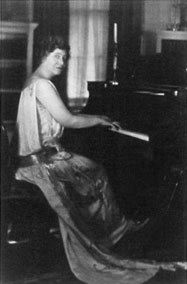"I must
say it has ever been the aim of the symphony to serve as a unifying
and democratic agency in our region and city, that music may reach
and touch every facet of our civic life."
Believing
that inherited money was a public trust, Miss Hogg became one
of Houston's most generous benefactors. It was typical that she
would want to share her great love of music with others. Compassionate
by nature and progressive in outlook, Miss Hogg was deeply concerned
with the welfare of all Texans. Having fought her own battle with
depression, she became a zealous proponent of mental health care.
In 1929 Miss Hogg established the Child Guidance Center in Houston,
the first organization of its kind in the nation. When her brother
Will died in 1930, she used his estate to establish the Hogg foundation
for Mental Health and Hygiene at the University of Texas at Austin.
Most of her own estate was also bequeathed to the foundation.
Although she never married or had children, Miss Hogg was committed
to public education.
In 1943 she
was elected to the Houston School Board, where she profoundly
improved the education of Houston's children. Many of her innovations
were of fundamental and far reaching importance, such as her insistence
that African-American students receive art classes as did white
students. Others were more subtle, such as her personal donation
of a fireplace to a kindergarten classroom so that the children
would feel at home. Miss Hogg also worked to preserve the heritage
of her family and her state. She restored the Varner Plantation
as well as her parents' first home in Quitman, Texas. And, after
restoring a number of Texas-German buildings in Winedale, Miss
Hogg donated them to the University of Texas at Austin for use
as a study center.
"While
I shall always love Bayou Bend and everything there, in one sense
I have always considered I was only holding my collection in trust."
Bayou Bend,
the gracious home set upon 14 acres of formal and woodland gardens,
was built for Miss Hogg and her brothers Will and Mike. Completed
in 1928, the house was designed by the talented architect John
Staub. Miss Hogg worked closely with Staub to develop an architectural
style uniquely suited to the Texas Gulf Coast. Inspired by early
American houses, Staub designed the interiors at Bayou Bend to
showcase Miss Hogg's growing collection of American antiques.
By the 1950's, the collection had achieved national prominence.
Although Miss Hogg had always intended to share these rare antiques
with the public, there was no museum in Texas capable of housing
the vast inventory. Her friend and fellow collector Henry Francis
du Pont encouraged Miss Hogg to establish a house museum as he
had done at Winterthur in Delaware. In 1957 she donated Bayou
Bend and its collection to the Museum of Fine Arts, Houston. Under
Miss Hogg's guidance, the comfortable home was transformed into
a superb showcase for American decorative arts. The house opened
to the public in 1966, but Miss Hogg continued to collect for
her beloved Bayou Bend until her death in 1975 at age 93. Today,
visitors to Bayou Bend continue to share the rich legacy of this
extraordinary woman.
top
